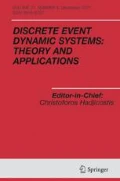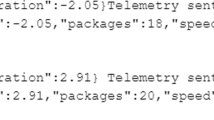Abstract
The paper addresses the optimal production control problems for an unreliable manufacturing system that produces items that can be regarded as conforming or nonconforming. A new stochastic hybrid state Markovian model with three discrete states, also called modes is introduced. The first two, operational sound and operational defective are not directly observable, while the third mode, failure, is observable. Production of defective parts is respectively initiated and stopped at the random entrance times to and departure times from the defective operational mode. The intricate, piecewise-deterministic dynamics of the model are studied, and the associated Kolmogorov equations are developed under the suboptimal class of hedging policies. The behavior of the model is numerically investigated, optimized under hedging policies, and subsequently compared to that of a tractable extension of the two-mode Bielecki-Kumar single machine model, where both conforming and defective parts are simultaneously produced in the operational mode, while the ratio of produced non conforming to conforming parts remains fixed.












Similar content being viewed by others
References
Algoet PH (1989) Flow balance equations for the steady-state distribution of a flexible manufacturing system. IEEE Trans Automat Contr 34:917–921
Bielecki T, Kumar P (1988) Optimality of zero inventory policies for unreliable manufacturing systems. Oper Res 36(4):532–541
Colledani M, Tolio T (2005) Impact of statistical process control (SPC) on the performance of production systems-Part 2 (large systems). In: Proceedings of the 5th international conference on analysis of manufacturing systems-production management. Zakynthos Island, Greece
Colledani M, Tolio T (2006) Impact of quality control on production system performance. Annals of the CIRP, vol 55
Colledani M, Tolio T (2009) Performance evaluation of production systems monitored by statistical process control and off-line inspections. Int J Prod Econ 120(2)
Colledani M, Tolio T (2011) Integrated analysis of quality and production logistics performance in manufacturing lines. Int J Prod Res 49(2):485–518
Gershwin SB (1994) Manufacturing systems engineering. Englewood Cliffs, NJ: PTR Prentice Hall
Kim J, Gershwin SB (2005) Integrated quality and quantity modeling of a production line. Spectrum 27:287–314
Kim J, Gershwin SB (2008) Analysis of long flow lines with quality and operational failures. IIE Trans 40:284–296
Malhamé R, Chong CY (1985) Electric load model synthesis by diffusion approximation of a high-order hybrid-state stochastic system. IEEE Trans Automat Contr 30(9):854–860
Mhada F, Hajji A, Malhamé R, Gharbi A, Pellerin R (2011) Production control of unreliable manufacturing systems producing defective items. J Qual Maint Eng 17(3)238–253
Sarra SA (2003) The Method of Characteristics and Conservation Laws. Journal Of Online Mathematics And Its Applications vol 3
Author information
Authors and Affiliations
Corresponding author
Appendices
Appendices
Derivation of Eqs. 7 and 12
The stock dynamics is defined by
therefore:
becomes:
by multiplying both sides of the equation by the same term, we get:
and since
Eq. 57 becomes:
We finally retrieve Eq. 7
Equation 12 is a special case of Eq. 7 where the initial points are \(x_1(0)=\frac{z\,d}{k}\) and \( x_2(0)=\frac{z(k-d)}{k}\):
Derivation of Eq. 10
The stock dynamics in the region x 1(t) + x 2(t) = z is defined by:
Substituting Eq. 59 in Eq. 58, we obtain:
Therefore
Integrating Eq. 60 with respect to time,we have:
i.e.
Hence, Equation 10 is retrieved:
Rights and permissions
About this article
Cite this article
Mhada, F., Malhamé, R. & Pellerin, R. A stochastic hybrid state model for optimizing hedging policies in manufacturing systems with randomly occurring defects. Discrete Event Dyn Syst 24, 69–98 (2014). https://doi.org/10.1007/s10626-013-0160-8
Received:
Accepted:
Published:
Issue Date:
DOI: https://doi.org/10.1007/s10626-013-0160-8




